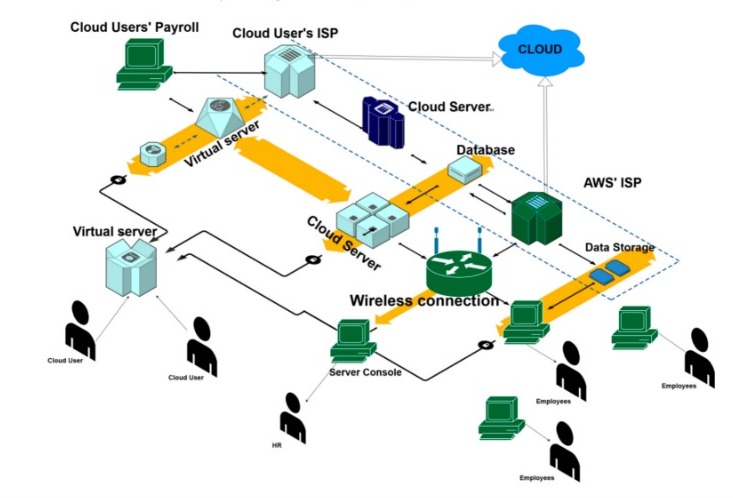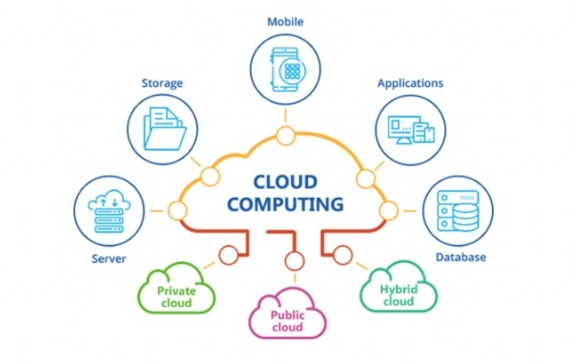CN7026 Cloud Computing Assignment Sample
HERE IS SAMPLE OF CN7026 Cloud Computing Assignment
Introduction
The project report is based on the case study provided where the financial company contains the requirement of implementing a cloud-based payroll system which could be responsible for monitoring all the salary payments of the employees considering the holidays, leaves and other segments. The employees also get the benefits whether they could monitor their payable salaries and choose the payment methods by which they want the payments.
All the details of payroll are to be determined by the cloud-based system so that both the parties could access and be aware of the salaries effectively. As the management and salary calculation in offline consumers takes much time and needs more paperwork with huge responsibilities, the cloud-based payroll system is taken into consideration here for enhancing the payroll departments resting the information system monitoring all the salary payments of their employees effectively.
Project plan
The project is entirely based on online cloud infrastructure. The Planning of the projects mainly directs to the effective payroll system where the cloud providers, i.e. AWS, Azure and etc. are taken into consideration that their SaaS services could be implemented in the financial departments and get the beneficial aspects from it. The objective of the plan is to provide and manage the payroll and economic system of any companies with the help of online cloud systems (Ryan and Lucifredi, 2018).
Therefore, the project plan is to acquire the SaaS services from any of the trusted cloud service providers and implement it in the organizations’ financial department with assigning all the holidays, monitoring the leaves taken by the employees and finally calculating the payable amount to the employees in real-time measurement so that they could always determine the amount to be paid to them with the dedication histories of their taken leaves.
Body: Cloud Architecture solution and Implementation
1.Requirements Gathering
The functional and nonfunctional requirements are always necessary for the software implementation, where it directs to the fundamental needs of the software to make the system more effective. Here the functional requirements are:
- The cloud-based software automatically validates all the employees managing the database of the organization’s employee list.
- The payroll system should allow the determination of the holidays and leaves are taken by the employees based on the academic calendar list of the organizations.
- The detailed information about the salary deduction of the particular employees will be provided, including all types of taxes and all.
- After the payment is made, the routing number along with the account types are provided to the employee’s profile which will be the evidence of the payment done.
The nonfunctional requirements of the cloud-based payroll system are:
- The employees are provided with the unique IDs and passwords for accessing their payroll details in the software.
- Employees are never given access for updating the salary information, and the only HR will be responsible for updating these types of information. Otherwise, it directs to the security administrator for unauthorized access.
- Employees will be able to monitor their salary information and the deduction histories along with the available leaves.
The significant risks in the financial departments of the organizations are mainly paperwork management where various risks could be faced in terms of maintaining all the data of all the employees. The cloud-based system will enable flexibility and transparency too to the employees and manage the vast data of the employees effectively (datacenterknowledge.com, 2020).
2. Choice of type of cloud platform
There are various cloud service providers available for providing the required solutions of the payroll system. But choosing the right one is always difficult among the different number of options. Here for the payroll system, the AWS is to be preferred as various types of advantages are there using AWS. The global presence of AWS is enormous, having best competition, storage capabilities, data and analytic services and the deployment services, which are the reason for choosing AWS in the implementation of the cloud-based payroll system.
It contains the most significant revenues among the other competitors worldwide where the majority of the markets are preferring AWS. Moreover, Amazon’s EC2 is responsible for offering free outbound bandwidth of approx. 1 GB which allows the users for getting the requirements of the bandwidths for the “cloud storage gratis”. Moreover, AWS contains the capabilities for throwing in the virtual storage space, computational power and bandwidth, avoiding all the unnecessary resources (Marinescu, 2017). AWS also eliminated all types of vexatious and unpredictable tasks so that it can offer more effective services. Moreover, the robust backup of AWS provides a 99.95% guarantee about their security systems and assures them with their backup protocols.
The high-grade securities also offered by AWS so that the data of the employees and the payment amount with their bank account details are to be secured by EC2 security protocols. These are the reasons that the EC2 cloud service provider is chosen here.
3. Choice of data center and standards
The data center contains the dedicated spaces where it stores all types of crucial information in it, relying on it to be safe and always accessible from any location. As the payroll systems are provided to consistently show the status of the payments and taxable amount of the employees,
it is quite evident that they have to access the system whenever they want to know about their remaining leaves and academic holiday lists with their pay slips too (Cronin et al. 2019). The standards are responsible for directing into the designing of the data centers. The design of the data centers and as well as the infrastructure standard contains the reigns from national to regional codes.
The data standard of the Uptime Institute is taken into consideration here for developing the performance-based designs in the data center. The reliability of the data centers is measured by the standards provided below (fingent.com, 2020).

Figure 1: Uptime Institute’s Tier Standard
(Source: https://www.datacenterknowledge.com/archives/2016/01/06/data-center-design-which-standards-to-follow)
4. Cloud System Architecture developed to solve the problem
The cloud solution is provided as the solutions of the problem in the payroll system where it is crucial that the data are securely stored in the cloud, and the entire system is provided by the cloud providers where the employees could log in to see their payroll status and HR department can provide justifications and do the calculations with the salaries of individuals so that it can provide the flexibilities to the users.
As the main problems are here to implement the cloud-based online payroll system, it can be solved by the proposed system architecture in the cloud system (guru99.com, 2020).


Figure 2: System architecture
(Source: Draw.io)
5. Implementation using any cloud platform
AWS is chosen here as the service provider here, which is beneficial for the payroll system, as mentioned in the above sections. Thus, the implementation of the system needs the requirements where it contains the higher speed data transmission rate with the effective data center having effective data Centre which directs to store and retrieve all the data about the employees effectively.
AWS platform provides seamless experiences with the application integration in the platform where the software application is to be provided by them regarding the payroll system (Martikainen, 2018). The hybrid applications are used here for managing and deploying the application in the cloud environment. It provides the availability, secured scalability and the agility, which made the financial departments of the organization get the success with minimal efforts.
The heavy traffic is predicted here as the number of employees is vast where it can provide the automation systems to handle the rush and heavy lifting are provided so that the system could run consistently providing the unified experiences (adolfogracia.com, 2020).
6. Analysis and Reflection
The system is to be implemented entirely based on the cloud infrastructure by the AWS cloud provider where the maintenance of the cloud infrastructure is entirely managed by the service provider itself. Therefore, it is beneficial for the organizations as most of the maintenance works are handled by the providers. All types of data centers are used here in terms of storing the data with the employee details maintaining the GDPR “General Data Protection Regulation ” ensuring all the privacy measures and starting the controls.
The data protection laws are crucially maintained by the service providers as well as the data centers based on the standards to ensure data security (Zhu, 2017). Moreover, the organizations also get an effective payroll system to manage the payments of all the employees, and transparent views are provided, which leads to a better understanding among the employees.
Conclusion
The report concludes that it is very obvious that implementing the cloud-based system will provide the various advantages to the organizations for managing and optimizing the payroll system. All the details of payroll are to be determined by the cloud-based system so that both the parties could access and be aware of the salaries effectively. It will be more effective than the paper-based system and help the workflow of the organizations in various segments. Additionally, all the payroll activities are to be done more effectively by the account managers so that the employees could get the facilities in an effective way.
Reference List
Book
Marinescu, D.C., 2017. Cloud computing: theory and practice. Morgan Kaufmann.
Ryan, M. and Lucifredi, F., 2018. AWS System Administration: Best Practices for Sysadmins in the Amazon Cloud. ” O’Reilly Media, Inc.”.
Journal
Cronin, A., Cusack, N., Duffy, G., Phelan, J. and Ryan, P., Flexiwage Ltd, 2019. Employee determined payroll payment processing method and system. U.S. Patent Application 16/345,433.
Martikainen, T., 2018. Migrating mainframe applications to the cloud.
Zhu, Y., 2017. Cloud computing: current and future impact on organizations.
Online article
adolfogracia.com, 2020, Fintech: Choosing a Cloud Services Provider, available at: http://www.adolfogracia.com/documents/PhillipsExecSum.pdf [Accessed on 26.5.2020]
Website
datacenterknowledge.com, 2020, Data Center Design: Which Standards to Follow? available at: https://www.datacenterknowledge.com/archives/2016/01/06/data-center-design-which-standards-to-follow [Accessed on 26.5.2020]
fingent.com, 2020, Why prefer AWS over On-Premise Hosting, available at: https://www.fingent.com/blog/why-prefer-aws-over-on-premise-hosting/ [Accessed on 26.5.2020]
guru99.com, 2020, Functional Requirements vs Non Functional Requirements: Key Differences, available at: https://www.guru99.com/functional-vs-non-functional-requirements.html [Accessed on 26.5.2020]
24/7 Chat Support | Get A+ Grade | Written by Top-Notch Subject Experts | 20% Off 1st Order |
Know more about UniqueSubmission’s other writing services:

